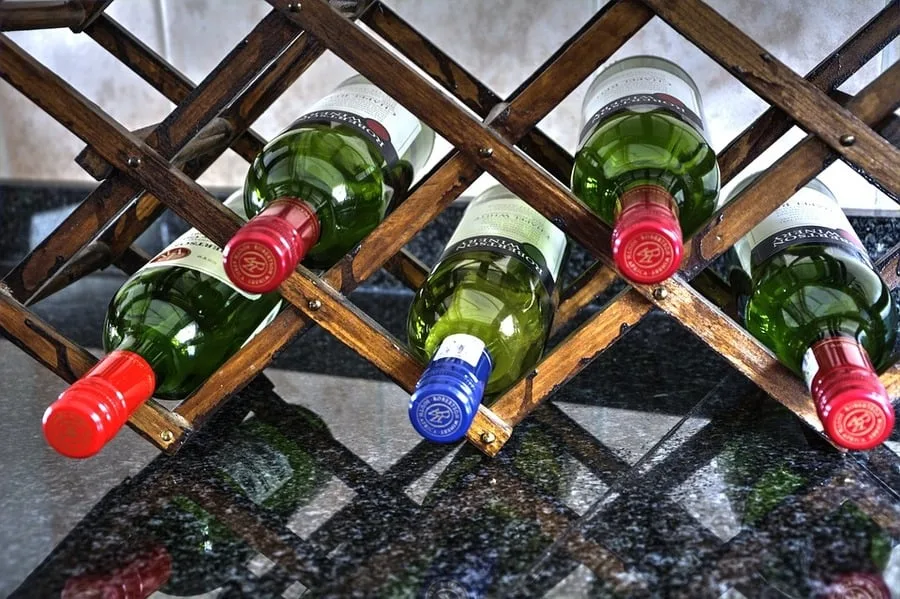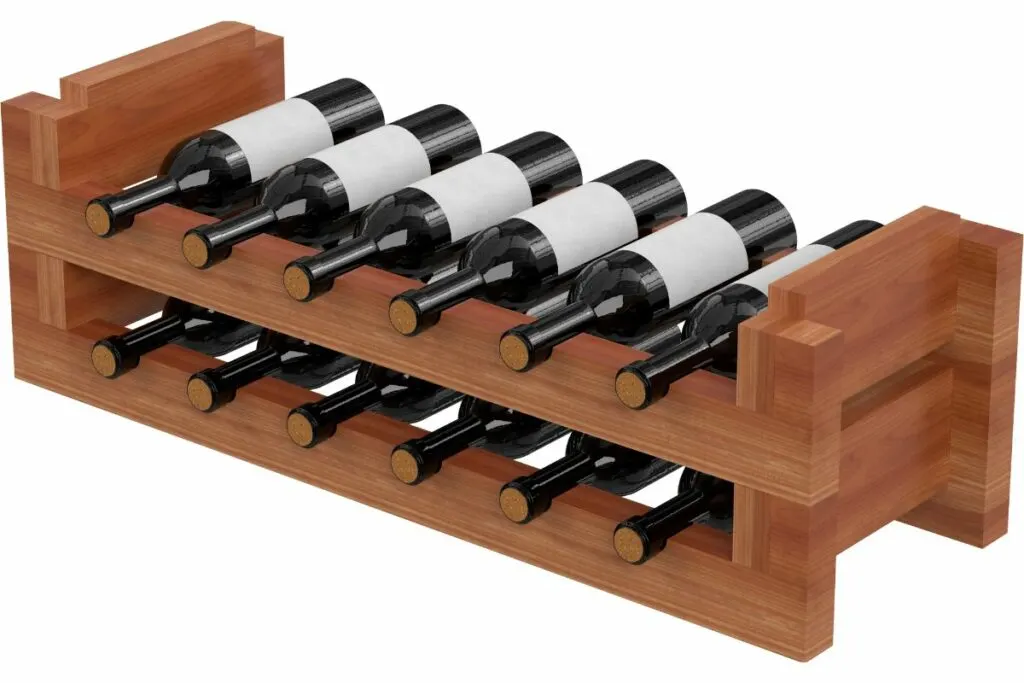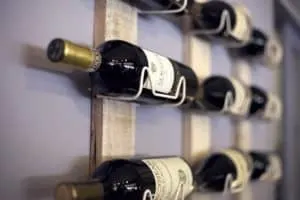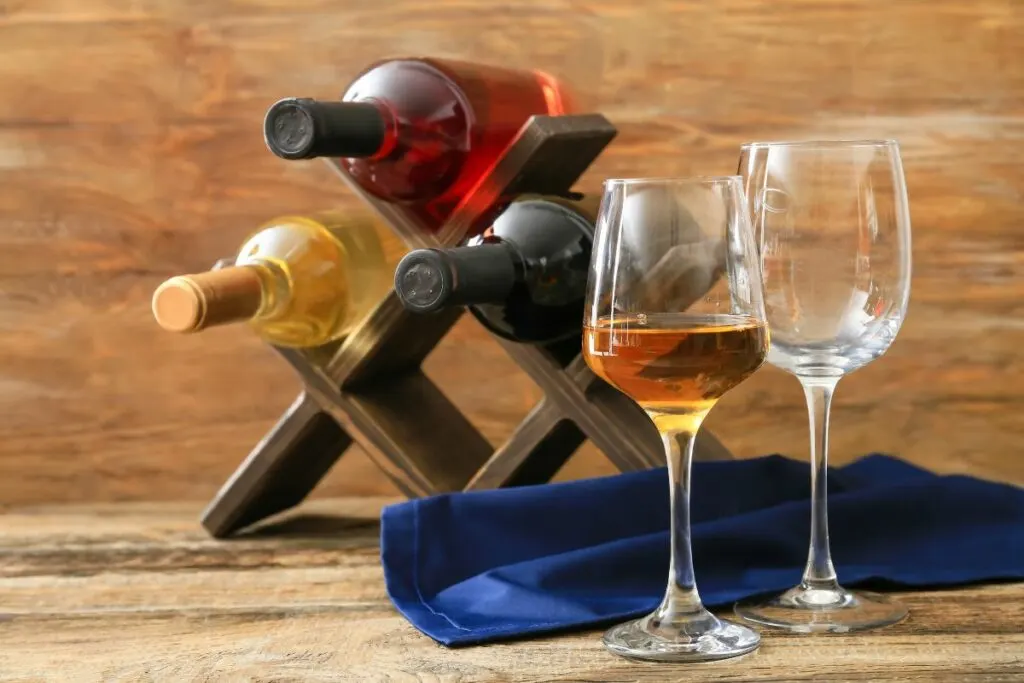As an Amazon Associate, I earn from qualifying purchases with no additional costs for you.
Wine racks are furniture pieces used to store often more than one bottle of wine. You can find them at your local wine store or even in your neighbor’s home. Instead of having multiple bottles scattered around a countertop, wine racks help to create a sense of organization in a kitchen pantry or bar space.
Why do wine racks lean forward? Wine racks lean forward to ensure that wine touches the cork, which is the light cylindrical and wooden object used to close a bottle. A wet cork will expand and therefore seal the bottle better. The larger the cork expands, the less air will enter the bottle and spoil the wine.
Not all wine racks found in stores lean forward, however. Even those tracks that seem like they are leaning may not always be at the optimal angle for storing wine. Knowing the importance of learning wine racks and how to identify the right orientation will ensure you preserve your wine better.

TIP: If you want to check out the best refrigerator for wine storage, I recommend trying out the Avation (18 bottles) compressor refrigerator with Wi-fi smart app control cooling system. You can find this refrigerator by clicking here (Amazon link).
Why Wine Racks Lean Forward
Leaning wine racks, available in everything from wood to metal, have multiple reasons for their orientation.
Preserve the Quality of the Wine
If wine bottles were placed in a purely vertical or horizontal orientation, chances are air bubbles will oxidize the wine changing the original taste to something nuttier. While nutty tastes fit the palettes of those who like sherry styles, they will deter others who like the light white wine taste.
Also not to mention if you were to store a sparkling wine in a non-leaning wine rack chances are the cork would remain dry. A dry cork would allow air bubbles to enter the sparkling wine and hence turn the wine flat. Experts say:
A typical cork will let in one milligram of oxygen a year
TIP: Can you properly store wine without a wine refrigerator? This article answers this important question. Have you ever wondered if you can store wine bottles upside down? Find out here!
Add an Aesthetic Appeal
A leaning wine rack also adds an aesthetic appeal to space. If you have a kitchen space where all your furniture is let’s say wooden pine, a wine rack can add both that sophisticated flare and an addition to your theme.
For the wine connoisseur, a leaning rack could demonstrate his or her level of dedication to the beverage.
Different Types of Leaning Wine Racks
If you are considering buying a learning wine rack or even making one, it’s important to understand the effects different orientations can have on the condition of your wine.
- 10 degrees: A wine rack that is tilted 10 degrees from a horizontal flat surface is considered optimally positioned. This will ensure just the right amount of wine touches the buoyant cork.
- More than 10 degrees: The danger of having a wine rack that is tilted very heavily is that sediments can start to build up near the cork. When it comes time to pour the wine, you’ll see chunks floating around in your glass, creating an unpleasant surprise.
Where Can I Find Leaning Wine Racks?

Leaning wine racks can be found on a myriad of different sites online. If you’re in a rush, you can easily find leaning wooden bamboo racks that can store up to 18 bottles on Amazon.com. However, if you aren’t a wine connoisseur and simply want storage for half the number of wine bottles, there is easy to assemble options available as well.
If you have a dinner party coming up, through Amazon prime, these bamboo racks may even arrive on the next business day.
However, if you have time to flip through your options and would even consider paying a store visit, then national chains such as Home Depot and Lowe’s may be your best bet. Both these stores have selections for rare wine consumers as well as enthusiasts.
TIP: Looking for a few quick life hacks on how to safely dispense your wine when serving guests? Read this article and this one – these tips could surprise you!
All good wines need good products. Read on to discover our favorites.
Recommendation box: Everything you need to enjoy your wine as much as possible. All recommended products are personally tested and regularly used by experts from this website (Amazon links):
> Ivation Wine Cooler – Energy-efficient wine cooler for 18 bottles with Wi-fi smart app control cooling system.
> Wine Rack – Beautiful, elegant wood rack for up to 7 bottles and the choice of vertical or horizontal storage.
> Durand Wine Opener – Classic vintage wine opener (we like all these classic staff).
> YouYah Iceberg Wine Decanter – The most beautiful and handy wine decanter we personally use.
> Bormioli Rocco Wine Glasses – A set of eight elegant and traditional wine glasses made in Italy.
> Vintorio Wine Aerator – Simple but really useful wine aerator for a reasonable price.
> The Original Vacu Vin Wine Saver – The best wine saver on the market in a package with two vacuum stoppers and two wine servers.
And if you want to become a true connoisseur of wine, we recommend reading the book Wine Folly: The Essential Guide to Wine (Amazon link), where you will find all the information you need about winemaking, wine varieties, flavors, and much more.
How Much Do Leaning Wine Racks Cost?
- Low budget
Leaning wine racks can be found for as low as $7.99, especially online. But usually, the strength and quality of the wine rack increase with price. Additionally, the more wine bottles you want to display, the greater the price will be. A budget-friendly leaning wine rack (Amazon) will at the most hold 10 bottles.
- Medium budget
For the wine consumer who wants a medium-sized leaning rack holding about 36 bottles (Amazon), he or she can expect to pay anywhere from $50 to $70.
- High budget
Lastly, for the more experienced wine collector who has 72 bottles to display they can expect to spend as much as a few hundred bucks (or more) for a durable leaning rack (Amazon).
But it is important to note that prices increase with the durability of the wine rack as well. A slender pine rack that may hold 10 bottles can cost you much less, but another pine rack that is built out of thicker and sturdier pine can cost you 5x or 6x more (Amazon).
TIP: Having quality storage racks for your wine is not only practical but can also serve as a nice design accessory for your home. We loved these (Amazon links):
- Ferfil Wine Rack (10 Bottles): Concertina/scissor fold wooden wine rack made of solid, eco-friendly wood.
- Gusto Nostro Wood Wine Rack: Beautiful, elegant design, the possibility of storing up to 7 bottles, and the choice of vertical or horizontal storage.
 How Do I Make My Own Leaning Wine Rack?
How Do I Make My Own Leaning Wine Rack?
Feeling frugal yet creative? Well, fortunately, you don’t have to spend too much money on a pre-designed leaning wine rack – you can make your own for as low as $20 (YouTube DIY).
But you need to have the following tools and materials below handy.
Tools:
- Jigsaw – a machine with a fine blade that allows you to cut curved lines in wood material
- Drill – a hand or power tool used to make holes in your pine boards
- Miter saw – a saw used to make crosscuts in the board
- Orbital sander – a device used to smooth off all rough edges on the wood
- Small clamps – used to hold small pieces of wood
- Large clamps – used to hold more significant pieces of wood
Materials:
- 1-2 Pine boards – wooden boards used for the wine rack
- Kreg coarse screws – zinc bits used to connect pine boards
- Wood stain – material used to color the wood for a refined finish
- Wood conditioner – assists with the wood absorbing the stain longer
Is a Leaning Wine Rack Enough?

While a leaning wine rack will help ensure that corks remain damp and seal off the bottle from the air, the consumer also has to play an active role.
Rotate the Wine
Experts recommend that those who own leaning wine racks still try to rotate their wine bottles every few months or so to ensure that enough wine is touching the cork. After all, as you consume more wine, there will be less in the bottle to touch the cork. Without the right dampness can crumble and dry over time.
Additionally, your wine may taste like vinegar or simply nothing close to what you bought it as.
Pay Attention to Temperature, Humidity, and Light
Another helpful reminder is that wine quality is ultimately based on a combination of humidity, temperature, and light. While a wine rack can assist with preventing air from entering the bottle, it will not help if the wine’s been kept in the blazing sun for a long period.
Temperatures above 70 degrees Fahrenheit tend to age the wine longer and spoil the taste. The optimal temperature for wine is between 45 degrees Fahrenheit and 65 degrees Fahrenheit.
Scientific studies by Pérez-Coello & colleagues (2003) and by Scrimgeour & colleagues (2015) both confirm that elevated storing temperatures can negatively affect the wine.
TIP: If you are looking for a different wine storage method, read this article for a few ideas. And then read this article to find out why wine coolers are so expensive.
Similarly, it is advised to store the wine in a dimmer location to avoid UV rays, which also age wine faster. This is why many wine experts place their leaning wine racks, usually in an underground cellar or their basement.
Unfortunately, the harsh truth is that a leaning wine rack might not be enough for all wines. The lighter white ones such as Chardonnay and Pinot Grigio taste best when they are drunk after opening the bottle as opposed to later.
TIP: Check out this page for a complete list of wine products and accessories I love. You’ll find my recommendations for wine refrigerators, decanters, and aerators and the best place to buy wine online. Click here to see the complete listing.
Scientific Literature Referenced:
Pérez-Coello, M., González-Viñas, M., Garcı́a-Romero, E., Dı́az-Maroto, M., & Cabezudo, M. (2003). Influence of storage temperature on the volatile compounds of young white wines. Food Control, 14(5), 301-306. doi:10.1016/s0956-7135(02)00094-4 (via: ScienceDirect)
Scrimgeour, N., Nordestgaard, S., Lloyd, N., & Wilkes, E. (2015). Exploring the effect of elevated storage temperature on wine composition. Australian Journal of Grape and Wine Research, 21, 713-722. DOI:10.1111/ajgw.12196 (via Wiley)
